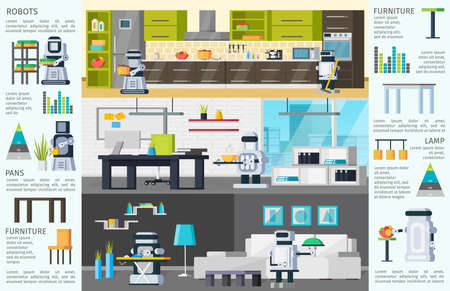Defining Modern Minimalism in American Homes
Modern minimalism has become a defining trend in American interior design, emphasizing simplicity, functionality, and a clutter-free environment. This design philosophy is rooted in the idea that less is more, favoring clean lines, neutral color palettes, and open spaces to create an atmosphere of calm and clarity. In recent years, U.S. homeowners have increasingly embraced minimalist principles, not just for their aesthetic appeal but also for their ability to promote mental well-being and efficient living. The typical modern minimalist home in America often features multi-purpose furniture, integrated storage solutions, and a focus on natural light. Minimalism’s popularity can be attributed to its adaptability; whether in urban apartments or suburban houses, it offers practical solutions for maximizing space and reducing distractions.
2. Key Smart Home Technologies Transforming Daily Life
Modern minimalist homes are increasingly defined by the seamless integration of smart technologies that not only enhance convenience but also elevate comfort and energy efficiency. Below is an overview of some of the most popular smart tech solutions found in American homes, illustrating how each contributes to a refined, effortless lifestyle.
Smart Lighting Systems
Smart lighting goes beyond basic illumination; it allows homeowners to set moods, automate schedules, and conserve energy with ease. Many systems can be controlled remotely or through voice commands, making them ideal for the minimalist who values simplicity and efficiency.
| Feature | Benefits |
|---|---|
| Remote Control | Adjust lights from anywhere using a smartphone app |
| Scheduling | Automate lighting to match daily routines or simulate occupancy when away |
| Energy Efficiency | Dimmable LEDs reduce power consumption and utility bills |
Climate Control Solutions
Smart thermostats and connected HVAC systems are pivotal for maintaining comfort in modern homes while optimizing energy use. These devices learn your preferences and adapt automatically, ensuring ideal temperatures without manual adjustment.
- Learning algorithms adjust heating and cooling based on usage patterns
- Geofencing capabilities sense when you’re home or away for optimal energy savings
- Integration with other smart devices to create holistic home automation scenes
Voice Assistants: The Heart of Home Automation
Voice assistants like Amazon Alexa, Google Assistant, and Apple HomePod serve as the central hub for managing smart devices. Their hands-free operation aligns perfectly with minimalist values—offering control without clutter or complexity.
Main Functions of Voice Assistants
| Function | Description |
|---|---|
| Device Integration | Centralizes control over lighting, climate, security, and entertainment systems |
| Routine Automation | Simplifies daily tasks by executing multi-step routines with a single command |
| Information Access | Provides news updates, weather forecasts, calendar reminders, and more on demand |
The Minimalist Advantage
The adoption of these key smart home technologies helps maintain the clean lines and uncluttered spaces synonymous with modern minimalism, while delivering a new level of personalized comfort and operational efficiency.

3. Seamless Integration: Blending Technology with Minimalist Aesthetics
One of the greatest challenges in modern minimalist homes is integrating smart technology without disrupting the clean, uncluttered look that defines this design philosophy. The key lies in strategic placement and selection of devices that either blend into the environment or remain virtually invisible until needed. Minimalism values simplicity, so every piece of technology must serve a clear purpose while maintaining visual harmony within the space.
Strategies for Discreet Integration
Homeowners and designers can achieve seamless integration by choosing low-profile devices, utilizing hidden installations, and coordinating finishes to match interior palettes. For example, smart thermostats with sleek touchscreens, in-wall speakers, and concealed wiring systems help preserve an open, airy feel. Many smart home products now offer customizable faceplates or neutral color options to further enhance their ability to fade into the background.
Practical Approaches to Maintaining Clean Lines
| Strategy | Description | Examples |
|---|---|---|
| Recessed Installation | Mounting devices flush with walls or ceilings to reduce visual clutter. | In-ceiling speakers, recessed lighting, hidden outlets |
| Multi-Function Devices | Choosing gadgets that combine several functions to minimize hardware. | Smart mirrors with built-in lighting and voice control |
| Cord Management Solutions | Utilizing cable channels or wireless charging stations to hide cords. | Wireless chargers embedded in countertops, cord covers matching wall color |
| Custom Cabinetry | Designing cabinetry to house and conceal routers, hubs, and other tech components. | Bespoke media consoles with ventilation for electronics |
The Balance Between Functionality and Style
A successful minimalist home does not sacrifice convenience for aesthetics. Instead, it finds harmony between the two by selecting technology that enhances daily living while remaining subtle. For example, voice-activated assistants can be placed in inconspicuous locations but still provide whole-home control. Similarly, motorized window shades can be programmed to operate automatically, removing the need for visible cords or manual adjustment. Ultimately, a thoughtful approach ensures that smart home innovations support both the lifestyle and visual appeal that American homeowners seek in contemporary minimalist spaces.
4. User Experience and Customization
One of the hallmarks of smart technology integration in modern minimalist homes is the focus on user experience and customization. American homeowners increasingly seek intuitive interfaces that simplify daily routines while reflecting their personal preferences. Devices like smart thermostats, lighting systems, and security solutions are now designed with user-friendly apps and voice commands, making it easy for everyone in the household to interact with technology, regardless of age or tech-savviness.
How Intuitive Interfaces Enhance Everyday Living
Smart home platforms such as Google Home, Amazon Alexa, and Apple HomeKit offer seamless control through simple voice prompts or touch screens. These interfaces are designed for ease of use, allowing users to manage complex systems without navigating confusing menus. Minimalist design principles are echoed in these streamlined digital experiences, eliminating unnecessary steps and visual clutter.
Personalized Automation: Tailoring Homes to American Lifestyles
Customization is key to maximizing convenience in American homes. Smart technology allows users to automate routines based on their unique schedules and habits. For example, lights can dim automatically in the evening, thermostats can adjust for energy savings when residents are away, and coffee makers can start brewing at a set time every morning. This level of personalization not only enhances comfort but also supports the busy, diverse lifestyles found across the United States.
Examples of Personalized Automation in Minimalist Homes
| Feature | Customization Option | User Benefit |
|---|---|---|
| Lighting Control | Adjust brightness & color by time of day or mood | Creates ambiance; saves energy |
| Climate Management | Set preferred temperatures for different zones/times | Optimizes comfort; reduces utility costs |
| Security Systems | Custom alerts & automation based on activity patterns | Enhances safety; provides peace of mind |
| Appliance Scheduling | Program appliances to operate during off-peak hours | Lowers bills; increases efficiency |
| Voice Assistant Routines | Create routines for morning/evening activities | Simplifies daily tasks; saves time |
The integration of intuitive interfaces and personalized automation elevates the living experience in modern minimalist homes. By adapting to individual needs and streamlining everyday tasks, smart technologies help Americans enjoy greater convenience while maintaining the clean lines and clutter-free environment characteristic of minimalist design.
5. Sustainability and Energy Efficiency
One of the most significant advantages of integrating smart technology into modern minimalist homes is the positive impact on sustainability and energy efficiency. Smart devices such as thermostats, lighting systems, and appliances are designed to optimize energy use, reducing overall consumption and lowering utility bills. This not only supports homeowners in their efforts to live more sustainably but also aligns with the minimalist philosophy of reducing waste and unnecessary resource usage.
Environmental Benefits of Smart Technology
Smart home systems can automatically adjust heating, cooling, and lighting based on occupancy and time of day, ensuring that energy is used only when needed. For example, smart thermostats learn user preferences and adjust temperatures accordingly, while smart lighting systems can be programmed or set to respond to natural light levels. This automated approach minimizes human error and maximizes efficiency, contributing to a smaller carbon footprint.
Key Features Supporting Eco-Friendly Living
| Smart Feature | Environmental Benefit |
|---|---|
| Smart Thermostats | Reduce heating/cooling costs by learning routines and adjusting settings automatically. |
| Energy Monitoring Devices | Provide real-time feedback on electricity usage, encouraging mindful consumption. |
| Automated Lighting | Dims or turns off lights when rooms are unoccupied, saving energy. |
| Smart Appliances | Operate at optimal times for efficiency; some adapt cycles based on load size. |
Long-Term Impact on Homeowners and the Environment
By leveraging these smart technologies, homeowners contribute to broader environmental goals such as reducing greenhouse gas emissions and conserving natural resources. Over time, the combination of lower energy consumption and increased efficiency translates into cost savings and a healthier living environment. Embracing these innovations not only enhances daily comfort but also reinforces a commitment to responsible, eco-friendly living—making smart technology an essential component in the evolution of modern minimalist homes.
6. Challenges and Considerations for Homeowners
While integrating smart technology into modern minimalist homes offers unmatched convenience and style, homeowners must be aware of potential drawbacks and challenges. The rapid adoption of digital devices can sometimes disrupt the clean, clutter-free aesthetic that minimalism champions. Below is a breakdown of common issues and practical solutions:
Potential Drawbacks
| Challenge | Description | Minimalist Solution |
|---|---|---|
| Device Overload | Too many gadgets can lead to visual clutter and overwhelm spaces. | Select multi-functional devices; conceal tech within cabinetry or walls. |
| System Compatibility | Integrating different brands or platforms may cause connectivity issues. | Choose a unified ecosystem or invest in hubs that support various protocols. |
| Maintenance Complexity | Frequent updates and troubleshooting can detract from simplicity. | Schedule regular check-ups and opt for devices with strong customer support. |
Privacy Concerns
The more connected your home, the greater the risk of data breaches and unauthorized access. Many smart devices collect personal information, from daily routines to security footage, which raises privacy concerns. Homeowners should:
- Change default passwords on all smart devices.
- Regularly update software to patch vulnerabilities.
- Review privacy settings and limit data sharing where possible.
Maintaining Simplicity Amid Digital Complexity
Balancing technological advancement with minimalist principles requires intentional planning. Here are some actionable tips:
Select Purposeful Tech
Invest only in devices that genuinely enhance comfort or efficiency. Avoid impulse buying trending gadgets that don’t serve your lifestyle needs.
Cable Management Strategies
Use wireless options when available, and install built-in cable organizers or discreet charging stations to preserve clean lines throughout the home.
Routine Tech Audits
Periodically assess all smart devices to ensure they’re still relevant and functioning well. Donate or recycle outdated equipment to prevent accumulation.
A Balanced Approach
The key to successful smart technology integration in modern minimalist homes lies in thoughtful curation. By proactively addressing these challenges, homeowners can enjoy both the sophistication of advanced tech and the tranquility of minimalist design.


